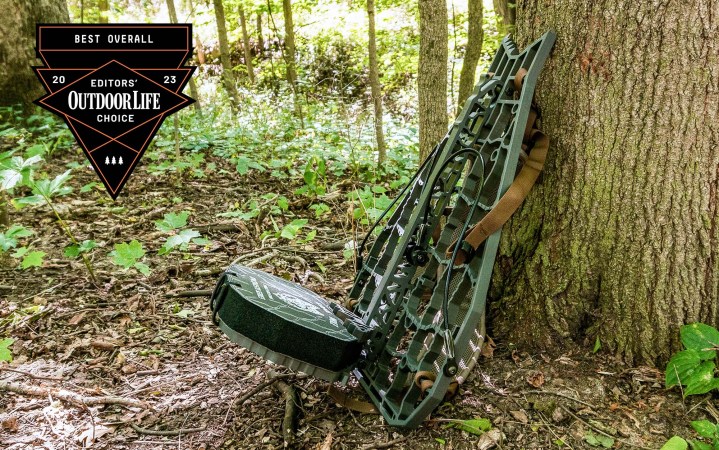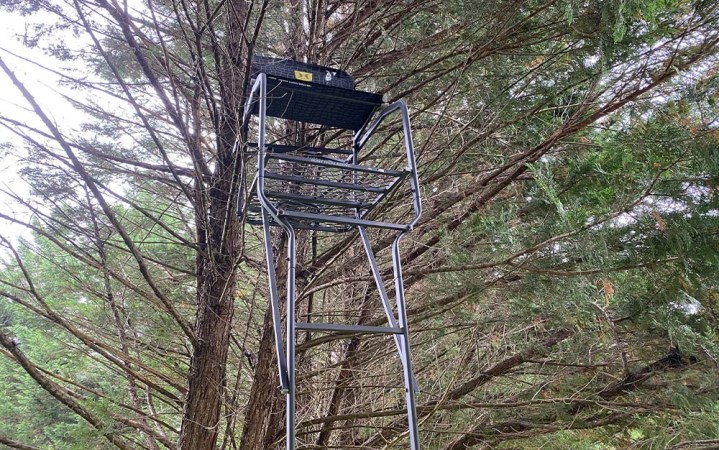We may earn revenue from the products available on this page and participate in affiliate programs. Learn More ›
We’ve come a long way from plywood and 2X4 tree stands that creaked like old wood floors and started to rot after several seasons in the elements. Today’s stands are much more sturdy, they’re also lighter, more comfortable, and quieter than stands many of us learned to hunt from.
There are a lot of options, too. From innovative small manufacturers to large established companies, there’s never been more brands making better tree stands than there are today. So, to help you find the best tree stand for your hunting style, we put 11 of the best tree stands through a series of tests.
- Best Overall: Lone Wolf Custom Gear .5 “Public Land Stand”
- Best Climbing Tree Stand: Lone Wolf Custom Gear Crossover
- Best Budget Climbing Tree Stand: XOP Outdoors Ambush Evolution
- Summit Titan SD
- Millennium M100U Ultralite
- XOP Outdoors Cold World
- Most Comfortable: Millennium M150 Monster
- Summit Dual Axis
- Hawk Helium Pro
- Ol’ Man Alumalite CTS
- Best Ladder Stand: Hawk BigHorn
How We Tested Tree Stands
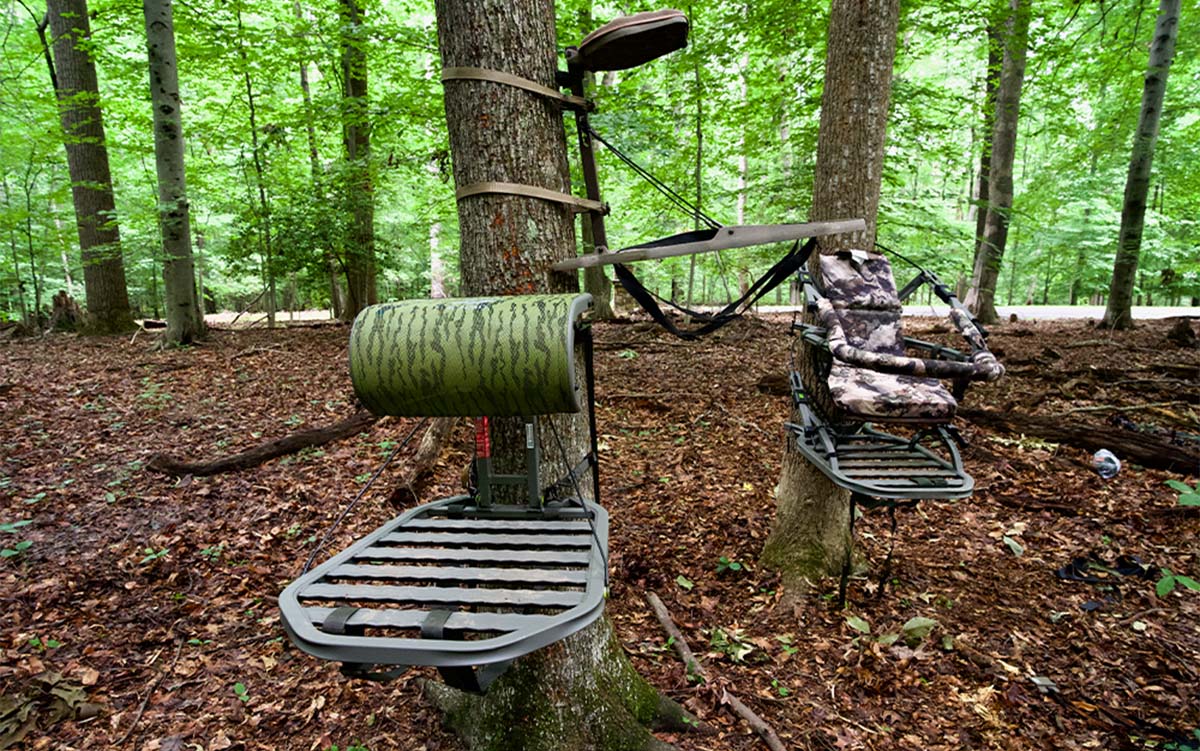
This review is broken into two sections: stands tested in 2023 and stands tested in 2022. The 2023 stands were tested by Erik Barber in Wisconsin. The 2022 stands were tested in Virginia by Scott Einsmann, Billy Philips, and Josh Philips.
While a year separated the two tests, the test protocol remained consistent. Here’s the full breakdown of the test team and our protocols and scoring system.
The Test Team
Erik Barber: A mobile hunter that lives and hunts in Wisconsin, but hunts multiple states for whitetails each year.
Billy Philips: Is an urban bowhunter who has the opportunity to hunt 365 days a year and takes full advantage of those opportunities with 150 days spent in a stand or saddle.
Josh Philips: Like his brother Billy, Josh is a four-season bowhunter with over 100 days spent in stands and saddles each year.
Scott Einsmann: Outdoor Life‘s gear editor and experienced mobile hunter.
Using our combined experience, we tested each stand with the following protocols:
Packability
To test how well a stand carried through the woods, we set up each stand in its pack configuration. Then, a tester carried the stand down a trail. The two testers who weren’t carrying stands stood along the trail, listening for any noise. We also carried the stands through thick woods to see if any part of the stand caught on brush. Each tester gave a score for packability from one to five, with five being the best. The packability score was determined by a stand’s carrying comfort, maneuverability, and perceived noise.
Speed
We timed how long it took to set up the stands on a straight tree with a 14-inch diameter. For the climbers, the testers started at the base of the tree with the stand on their back and then climbed to ten feet (base of the platform). For the hang ons, we pre-set two climbing sticks. Then started the clock once they began climbing and stopped the clock when they were standing on the platform. You’ll see these times in the key features section for each stand.
Noise
While we were hanging each stand, two testers stood on opposite sides of the tree and scored the perceived noise level on a one to five scale (five is the quietest).
Comfort, Stability, and Shooting
We tested all the stands for comfort and stability and shot our bows from the stands. We gave each stand a comfort score on our one-to-five scale, with five being the most comfortable. We judged comfort sitting in the seat but also factored the stand’s comfort while standing.
We defined stability as movement felt while on the stand. So, any wiggle or bounce was noted as we moved around on the platform. We also shot seated and standing to gather notes on the shooting experience. You’ll see notes on stability and shooting experience in the product description of each stand.
Tree Selection
We tested each stand on trees of different diameters as well as straight and leaning trees.
The Best Tree Stands: Reviews and Recommendations
Best Overall: Lone Wolf Custom Gear .5 “Public Land Stand”
Score Card
- Packability Score: 5
- Noise Score: 5
- Comfort Score: 4
- Setup Time: 1 minute 58 seconds
Key Features
- Weight: 5.8 pounds
- Platform Dimensions: 23 x 16.5 inches
- Comes with robust, high-quality backpack straps
- Price: $500
Pros
- No assembly required
- Made in USA (even the backpack straps)
- Seat locks in place to support heavy loads
Cons
- Includes one cam strap buckle
I tested a lot of impressive tree stands, but the Lone Wolf Custom Gear .5 was the lightest, easiest to hang, and nearly silent during setup.
The .5 is made for mobile hunting, and it has a lot of features that make it one of the easiest to pack hang ons. The .5 was very quiet while packing or hanging it, and I especially appreciated the compact profile for sneaking through thick cover without getting hung up. I found it very easy to hang, producing the only sub-2-minute setup time of the test. The Lone Wolf Custom Gear climbing sticks securely lock into place on the stand with no rattling. When stowed into pack mode, the seat locks into the stand’s frame and doubles as a load shelf to support a backpack, extra layers, or even a quartered whitetail.

The .5 is marketed as a stand for mobile hunters, but I’m confident it’s a superior option for anyone regardless of their hunting style. Whether you want to tuck away and disappear into a cedar tree or perch comfortably in your favorite white oak, the .5 is versatile enough for a wide range of hunting styles. You can even hybrid hunt from it—saddle hunting from a tree stand. However, if you plan on running your tree saddle, I’d recommend adding a second cam strap buckle to the bottom of the post to eliminate any kickout.
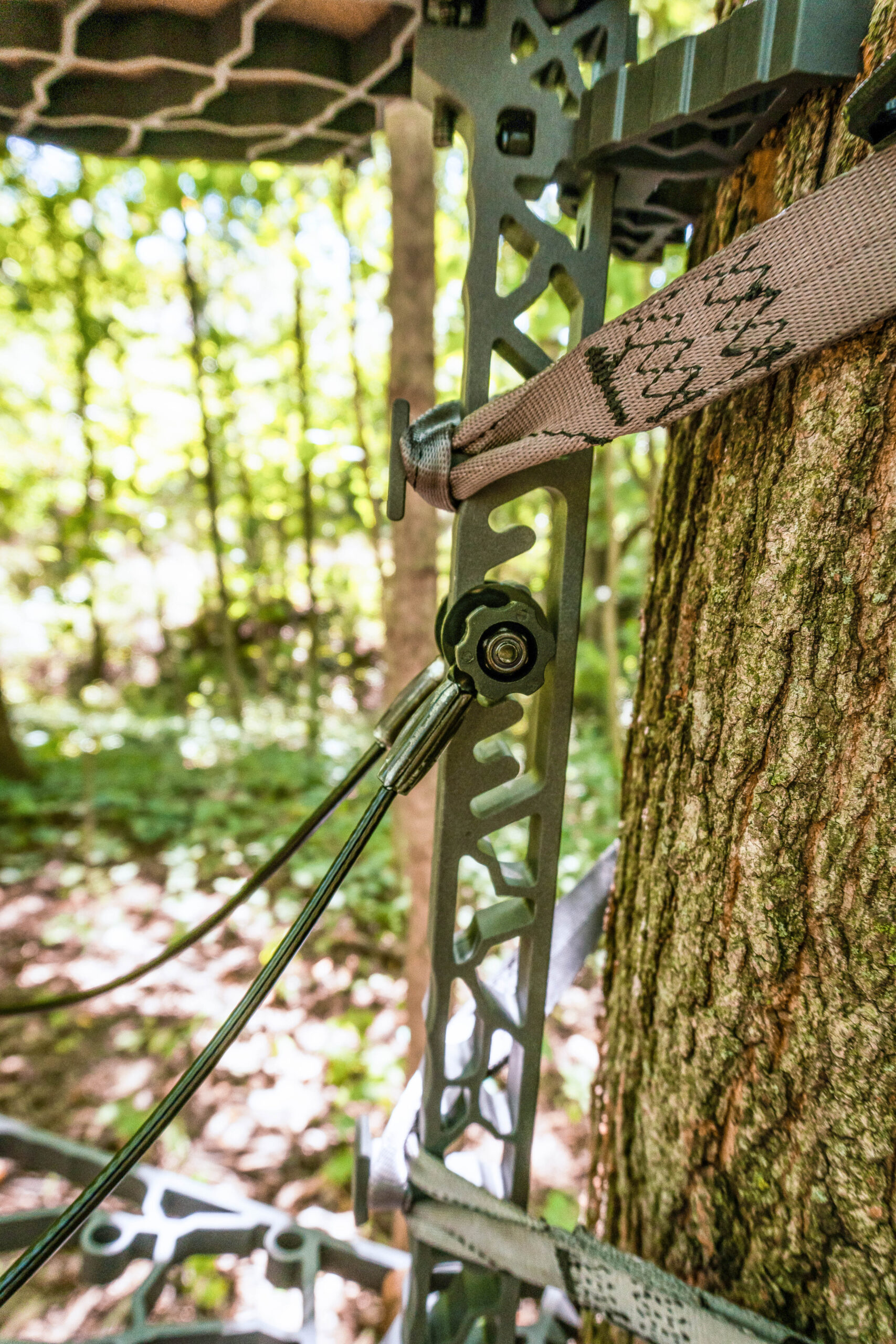

The carrying straps included with the .5 hang-on tree stand were a surprise. I usually toss the backpack straps included with stands and purchase them separately, but the Lone Wolf Custom Gear straps are a rare exception. They’re thick, contoured to fit your chest and shoulders comfortably, and even include a load lifter system and sternum strap to maximize the load-carrying capacity of your stand.
Best Climbing Tree Stand: Lone Wolf Custom Gear Crossover
Score Card
- Packability Score: 5
- Noise Score: 5
- Comfort Score: 4
- Setup Time: 5 minutes 12 seconds
Key Features
- Weight: 11.5 pounds
- Platform Dimensions: 24 x 16.5 inches
- Packed Profile: 1 ⅞ inches
- Comes with robust, high-quality backpack straps
- Price: $1,000
Pros
- Made and designed in USA
- Use as a hand climber or sit-and-climb
- Silent when climbing
Cons
- Expensive
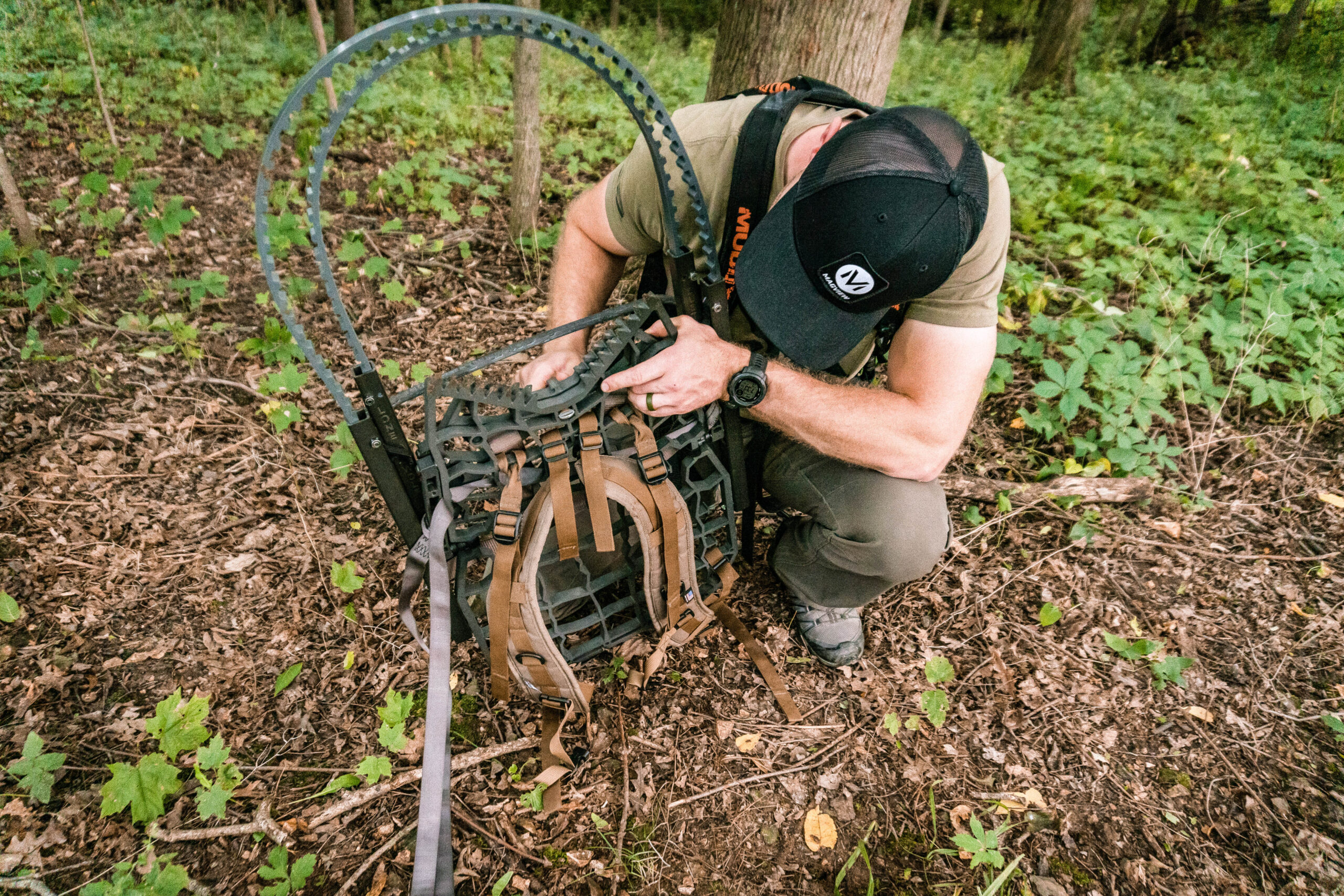
The Lone Wolf Custom Gear Crossover climber is the lightest, most packable climbing tree stand on the market. It folds flat using rubber grommets to lock the stand in place at a sleek 1 ⅞-inch packed profile. The rubber grommets cut noise drastically while you’re walking to your stand. The compact profile avoids snags on twigs and limbs, which allows you to sneak undetected through the timber.
The Crossover can be used as a hand climber or sit-and-climb by simply folding the sit bar into place or out of the way. I preferred hand climbing during the test and felt I could make longer strides up the tree. However, the 9-ounce sit bar adds minimal weight and is a comfortable place to rest your arms for longer sits.


At first glance, I doubted the seat’s comfort, but it was surprisingly comfortable. Production models weren’t available at the time of the test, so the model I used only had the webbing material, similar to a seatbelt. It provided plenty of support for me to sit comfortably for several hours. I especially liked how the seat tucked back into the stand without using my hands by simply pushing it back with my hips. It’s easy, and helps you tuck tight to the tree and stay concealed while standing.
Like all Lone Wolf Custom Gear stands, the Crossover features multiple bow holder ports and seven different tie-down cleats in the platform, including a main center cleat for attaching a backpack. While the stand can be packed with the belts up or down, I found it most comfortable to pack it with the belts up to prevent it from bumping against the back of your legs while walking.
At $1,000, the Crossover isn’t cheap. However, it’s backed by LWCG’s lifetime, transferable warranty. It’s a disrupter in tree stand technology, and made me reconsider the way I think about climbing stands.
This is the ultimate stand for comfort, and it’s also a great stand for introducing new hunters to treestands because of its large platform.
Millennium M100U Ultralite
Score Card
- Packability Score: 2
- Noise Score: 3
- Comfort Score: 5
- Setup Time: 4 minutes 43 seconds
Key Features
- Weight: 14.5 pounds
- Platform Dimensions: 20 x 38 inches
- Comes with a tree stand safety line
- Price: $305
Pros
- Most comfortable stand in the test
- Spacious platform
Cons
- Camlock Receiver brackets are awkward to hang from
- No leveling adjustments
- No bottom cam strap buckle
The Millennium M100U Ultralite is so comfortable you could sleep in it because of how the huge 20 x 16-inch seat captures and cradles your lower back and rear. At 38-inches long, the platform gives you plenty of space to maneuver for awkward shot angles or reposition yourself to find a hole through cover. If I could’ve given it a comfort score higher than 5, I would have. When you’re done with your hunt, the seat folds up and is contained in the upward position with a conveniently placed bungee cord.

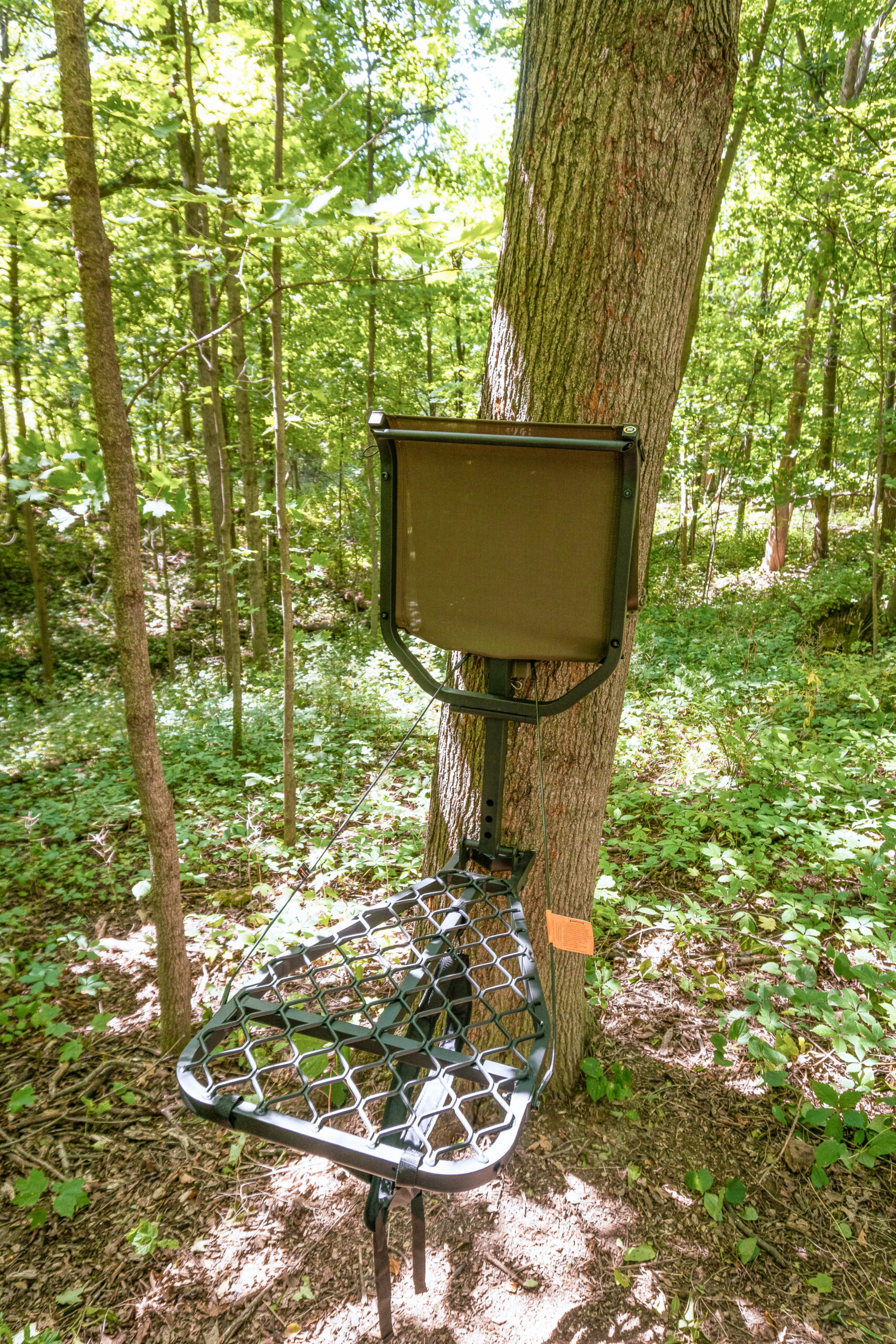
The M100U ships with an included Camlock Receiver bracket. The bracket is attached to the tree with a chain system, which I found awkward to hang because you need enough slack to thread the carabiner through. The chain isn’t exactly quiet, which earned it a modest noise score. You can upgrade to a Camlock Receiver with a ratchet strap, but at $42, I felt that was a bit steep. I liked that the stand simply slides into the bracket once it’s set up, but felt it would have benefited from a cam strap buckle at the bottom of the post to eliminate any potential kickout.
While you could hang several Camlock brackets throughout your hunting property and move your stand from one bracket to the next, I wouldn’t recommend it. The platform is long, and I noticed a bit of rattle and metal-on-metal contact during transport. The M100U is best suited to permanent or semi-permanent setups, especially those in locations you expect to sit all day during the rut.
Best Budget Climbing Tree Stand: XOP Outdoors Ambush Evolution
Score Card
- Packability Score: 4
- Noise Score: 3
- Comfort Score: 4
- Setup Time: 5 minutes 27 seconds
Key Features
- Weight: 18 pounds
- Platform Dimensions: 30 x 16 inches
- Packed Profile: 4 inches
- Price: $330
Pros
- Affordable
- Use as a hand climber or sit-and-climb
- Lifetime warranty on all metal
Cons
- Requires some assembly
- Instructions aren’t user friendly
- Noisy

At $330 the XOP Ambush Evolution is a good climber at a reasonable price. The Ambush Evolution is much more compact than other climbing tree stands in this price range. With a packed height of just 4 inches, it’s significantly sleeker than the pricier Summit Titan SD, which costs $420.
Once set up, the Ambush Evolution is comfortable and spacious. Like the Lone Wolf Custom Gear Crossover, it can be used as a hand climber or sit-and-climb, which provides flexibility regardless of your climbing preference.
The included backpack straps aren’t anything to write home about, but can be easily upgraded. The components that lock the seat and platform in place were noisy enough that I’d be concerned when setting up close to a bedding area. I also noticed some minor rattling from the platform while climbing, so I’d suggest wrapping it in some noise-dampening material.
Summit Titan SD
Score Card
- Packability Score: 1
- Noise Score: 2
- Comfort Score: 5
- Setup Time: 5 minutes 12 seconds
Key Features
- Weight: 25 pounds
- Platform Dimensions: 21 x 38.5 inches
- Packed Profile: 15 ½ inches
- Price: $419.99
Pros
- Comfortable
- Rock solid gun rest
Cons
- Heavy
- Noisy
- Bulky
My first tree stand was a Summit, and since then, they’ve always held a special place in my heart. The brand has been around seemingly forever, and their designs haven’t strayed far from my original nearly 20 years ago. If you’re not making long treks and want a comfortable climbing tree stand, the Titan SD is a great option.


The Titan SD prioritizes comfort over everything. The result is a climbing tree stand that’s arguably more comfortable than a La-Z-Boy recliner and can support up to 350 pounds, designed specifically for larger framed hunters. The stand’s wraparound gun rest is rock solid and allows plenty of points of contact to make for steady shots in the field.
Don’t expect the Titan SD to break any land speed records. At 25 pounds and a packing profile of 15 ½ inches, it’s the bulkiest stand in the test. I found it difficult to pack and unpack the stand silently, and while the Quick Draw cable retention system grips the tree effectively, retracting and inserting the cables produces a significant amount of noise.
Once attached to the tree, the RapidClimb Stirrups allowed me to climb quietly and confidently. The stirrups position a bungee cord behind the ankle, which helped me rotate my feet in a controlled manner to prevent any unnecessary rubbing from the cable against the tree while climbing. When it comes to climbers, I think Summit is at the top of the list in terms of safety and security while climbing. My dad felt that way more than 20 years ago when he bought me my first Summit, a stand that’s still operable today.
XOP Outdoors Cold World
Score Card
- Packability Score: 4
- Noise Score: 4
- Comfort Score: 5
- Setup Time: 2 minutes 49 seconds
Key Features
- Weight: 7.5 pounds
- Platform Dimensions: 17.5 x 26 inches
- Price: $450
Pros
- Intuitive leveling system
- Dura-Grip coating provides incredible traction
- Lightweight
- Comfortable seat
Cons
- Doesn’t come with backpack straps
Then new XOP Outdoors Cold World has a different look and feel from previous XOP hang ons, most notably because of the tacky Dura-Grip coating, which is ideal for hunting in rain or snow.
In the seat, I immediately noticed the extra padding. While seat height comes in at a standard 18 inches, the four-layer insulated seat cushion (treated with DWR to shed moisture) provides an extra 3 inches of padding. The result is a 21-inch seat height, which allows taller guys like myself to keep their legs a bit more extended. This might sound like fluffy number crunching, but I’ve noticed my legs fall asleep quicker when at acute angles for extended hours.

The stand’s self-leveling system is easy to use. Just loosen the cable connection, reposition it on the post until the platform is level, and tighten. The seat has a threaded knob to accommodate different angles, but produces metal-on-metal contact out of the box. To remedy this, simply place an adhesive felt slider pad on the threaded leveling post where it contacts the stand’s frame.
At 7.5 pounds, the Cold World is the second lightest stand in the test. Unfortunately, it doesn’t come with backpack straps, which I’d recommend adding if you plan to purchase it. Most high-quality backpack straps come in around $50, and will turn the Cold World into a mobile hunter’s go-to option.
2022 Tree Stand Test
Summit Dual Axis (Best Overall Winner)
Key Features
- Weight: 16 pounds
- Tree Diameter: 8 to 20 inches
- Uses two ratchet straps
- Comfort Score: 5
- Noise Score: 4.5
- Setup Time: 3 minutes 56 seconds
Pros
- Bites the tree exceptionally well
- Easy to go from seated to standing
- Silent once attached
Cons
- Not ideal for mobile hunting
We were impressed with the entire field of tree stands, but the one that stood out as being the best tree stand of the bunch was the Summit Dual Axis.
We found the stand easy to hang with the two included ratchet straps. It was fairly quiet during setup, with the only real noise coming from the ratchets. It was silent once on the tree thanks to a few smart features. Each connection point has Teflon washers, so you’ll never have to worry about an ill-timed squeak blowing your hunt. Also, Summit’s Dead Metal Sound Deadening Technology fills portions of the stand with expanding foam. We tested that tech by tapping our metal wedding bands against the stand and were impressed with the dull, muted sound rather than a high-pitched “ting.”
The Dual Axis’ teeth bit the tree better than any of the stands we tested, and it was the most stable. In the stand, we didn’t notice any movement. It bit the tree so well that when we removed the straps, it stayed connected to the tree, and we had to pull it off.


The Dual Axis’ seat was our favorite feature and one of the main things that made it one of the best hang-on tree stands. It isn’t a seat that’s built to rock you to sleep. But it does keep you comfortable while you’re waiting for a shot. We especially liked how easily we could transition from sitting to standing. We’ve all sat in stands with seats that are like comfy recliners, but getting out of them is just like getting out of your favorite chair—you can’t get out without effort and a groan. That doesn’t work for bowhunting. You need a chair that is easy to stand from and puts you in a good posture for seated shots. That’s what the Dual Axis seat offers. If you need to stand for a shot, it’s very easy to pop up.


Also when you flip up the seat, it turns into a comfortable backrest. The seat locks in the upright position so it won’t unexpectedly drop on you. To unlock the seat, lift up and ease it down. It is important to mention that we all found the seat very comfortable and thought it was good to go for an all-day sit. An interesting thing we discovered during testing is that the seat makes for an excellent knee rest for saddle hunting, and if you scaled the stand down just a little, it would make for a great saddle platform.
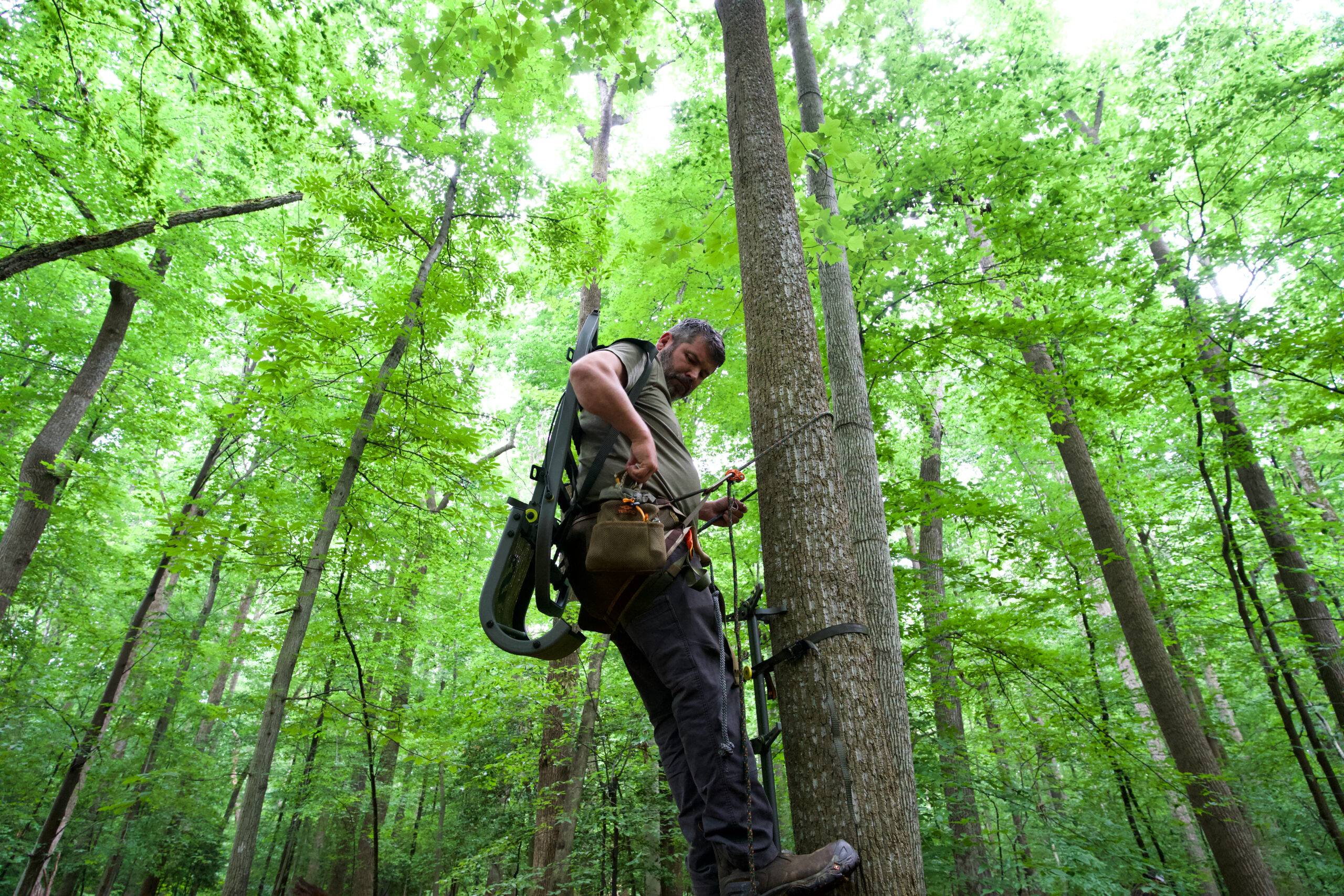
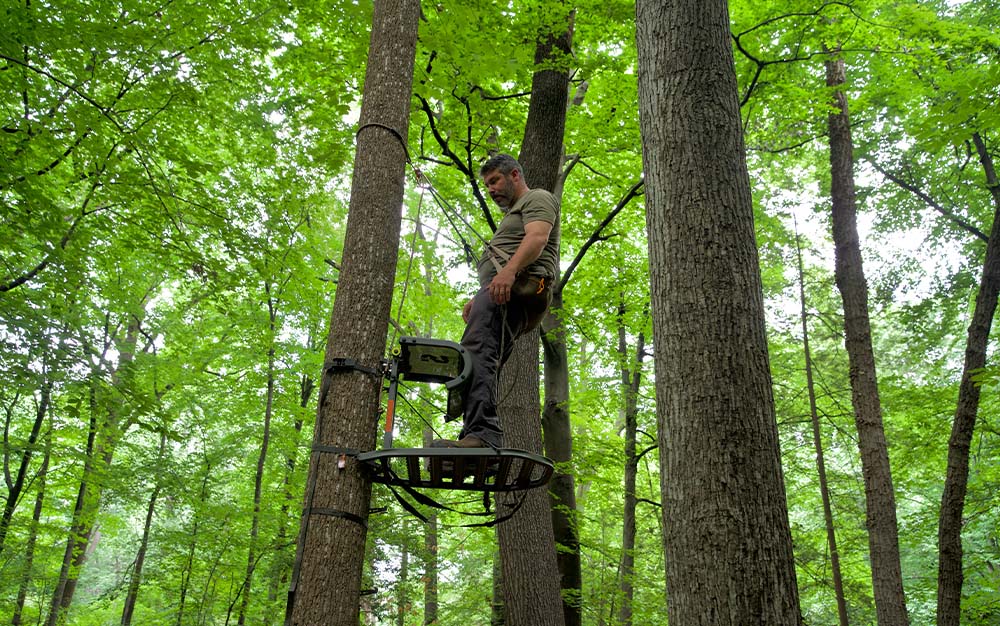
At 16 pounds, the Dual Axis is a little heavy for a hang and hunt. But it could fill that role if you’re running lightweight sticks. We think it shines for presets and as a semi-permanent stand.
Most Comfortable: Millennium M150 Monster
Key Features
- Weight: 19.5 pounds
- Adjusts to leaning trees up to 15 degrees
- Platform Dimensions: 24 inches wide and 37 inches deep
- Comfort Score: 5
- Noise Score: 4
- Setup Time: 3 minutes 56 seconds
Pros
- Comfortable
- Giant Platform
- Easy to hang
Cons
- Some movement to the stand
Millennium is known for their great seats, so it shouldn’t be surprising that we unanimously picked the M150 Monster as the most comfortable. It’s the type of stand you can nap in and actually get quality sleep. The seat is mesh and has just the right give for comfort. It has a slight recline, and the straps act as nice armrests. The M150 has a footrest for added comfort. One drawback of the seat is that it isn’t the easiest to stand up from. Getting up takes effort because your butt sits lower than your knees in the stand, but that’s also why it’s so comfortable.


If you like lots of space, this is your stand. Its giant platform allows you to leave the seat down and still have plenty of standing room. The large platform isn’t just about comfort. The extra real estate made it easy to shoot nearly 360 degrees in the stand with a bow because you can stand away from the tree for shots behind the stand. The downside of the long platform is that it has more bounce than a shorter stand. From the ground, the movement was obvious, but it’s barely noticeable when you’re in the stand.
To hang the stand, you first strap the receiver to the tree and then slide the stand onto the receiver. The receiver is a genius method for hanging a large stand, and it eliminates the need to hold a nearly 20-pound stand with one arm while you secure the strap with the other. Instead, you just drop it into the receiver and finish securing the stand.
Hawk Helium Pro
Key Features
- Weight: 12 pounds
- Platform leveling adjustment
- Platform Dimensions: 24 inches wide and 30 inches deep
- Comfort Score: 3.5
- Noise Score: 3
- Setup Time: 3 minutes
Pros
- Easy to level
- Fast to hang
Cons
- Needs upgraded backpack straps
The Hawk Helium Pro is a 12-pound stand and a good option for mobile hunting with a few modifications. First, we’d remove the adjustable footrest because we found the seat can get caught in it during setup, and it’ll cut some weight. We’d also suggest upgrading the backpack straps—they’re pretty Spartan. You can buy padded aftermarket straps for under $50 from several providers.

The Helium was fast to hang, although a little noisy, and only uses one cam-buckle strap to connect to the tree. The strap connects to the stand with plastic-coated metal hooks, which help cut noise. We found the platform and seat leveler very easy to use and took just seconds to adjust. We had some difficulty getting the Helium Pro tight to the tree because it wouldn’t bite the tree well and cam-locking didn’t help much either. That’s likely why we noticed more movement while standing and shooting from the helium than other stands. It does have a nice roomy platform with good grip.
The seat cushion is thick and comfortable for half-day hunts, but it is foam so you probably don’t want to leave it out for an entire season.
Ol’ Man Alumalite CTS
Key Features
- Weight: 21 pounds
- Platform Dimensions: 18 inches wide and 32 inches long
- Packability: 4
- Comfort: 4
- Noise: 2.5
- Set up and climbing time: 11 minutes, 9 seconds
Pros
- Packs great
- Super comfortable seat
- Feels lighter than its actual weight
Cons
- Noisy setup
If your hunt starts with a one mile hike, then the Ol’ Man Alumalite CTS is the best climbing tree stand for you. We were impressed with how well this stand packed. It folds down flat and has a narrow profile, so it won’t be wider than most hunter’s shoulders. And because the stand sits close to your body it feels lighter and maneuvers well. You can improve the packability by adding padded straps and an additional bungee to secure the cables.


While we loved carrying the stand, getting it on the tree and ready to climb wasn’t a walk in the park. There’s a few design flaws that slow down the process and make it a lot noisier. One of the main ones is that the cables slide into a tube and are secured with a pin. Matching the hole in the stand to the hole in the cable takes a little trial and error. But once you get it all adjusted, it climbs quickly. In fact it was twice as fast as the Summit for climbing.

At hunting height, we liked the stand’s seat and considered it to be plenty comfortable for an all-day sit. But, the handrails tighten down when you sit, so it might not be comfortable for a larger hunter. Also, if you have anything on your belt like a knife or fanny pack, it will get caught in the handrails when you stand.
Best Ladder Stand: Hawk BigHorn
Key Features
- Height: 20 Feet
- Weight: 82 Pounds
- Platform Size: 23.5 inches wide X 30 inches deep
- Assembly Time: 2 hours
Pros
- Fast assembly
- Comfortable
Cons
- Pricey
All of us in the test group are mobile hunters, but we never pass up an opportunity to hunt from a ladder stand. The nice seats and easy climb make them a luxury. But, we’ve also all climbed rickety ladder stands with metal seats and no padding. The Hawk Bighorn is definitely not rickety or uncomfortable, and after testing, we think it’s one of the best options in ladder stands.

We started the test by laying out all the pieces and building the stand. Putting together any ladder stand is a project, and the best tree stands go together easily. We found the directions to be OK. The stand pieces are not labeled so you’ll have to study the photos carefully as you go through each step. Another area of confusion is that some of the bolts are very similar with just a ¼ inch difference in length, so be sure to organize them before you start tightening bolts. Our total time of assembly was two hours and that included a few mistakes that needed to be undone and fixed. We recommend driving the stand as close as you can to its final location and then assembling the stand. Building it in one location, and then carrying it in pieces is possible but harder than building it at the site. Also, one person can set up the stand, but two people make the job much easier.

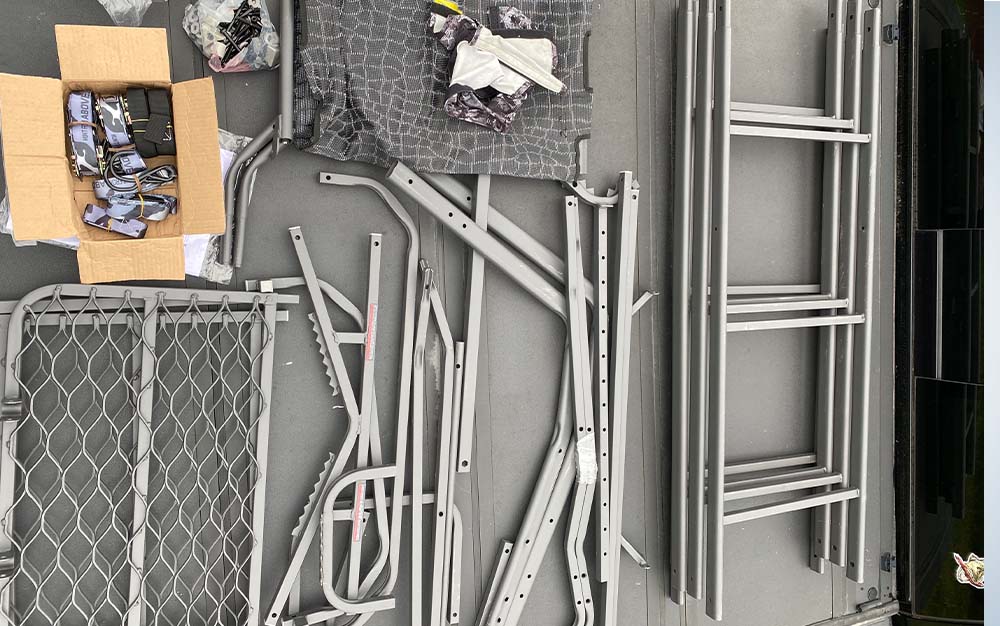
We found the stand to be solid once on the tree and very comfortable. Hawk has some nice features like two accessory hooks for hanging rattling antlers, a bowhunting backpack, or extra layers. We decided to leave off the arm rests and gun rest because we placed the stand on a bowhunting-only property, but they’re a great features for gun hunters. Another feature we liked was the wide ladder steps which were very easy to climb.
How to Choose a Tree Stand
The first and most important step in choosing a stand is deciding between a hang-on, climbing, or ladder tree stand. Here are some factors to consider when choosing the type of tree stand that’s right for you.
Hang-On Tree Stands
The main advantage of a hang-on is their versatility. They can be used in just about any tree and are easily moved if you need to adjust stand location. You can also pack them in, hang them, and take them down each time you hunt. That’s important for public land hunters and private land hunters that only want to buy one stand. Unlike climbers and ladder stands, a hang on needs climbing sticks or steps in addition to the stand. So you have added cost and complexity to the system.
Climbing Tree Stands
A climbing stand is both your hunting platform and climbing aid. These self-sufficient systems are ideal for public land hunters. They do have two main drawbacks: they’re heavy and can only climb straight, limbless trees.
Ladder Stands
You can’t beat the convenience of a ladder stand. They’re the easiest to climb and very comfortable to hunt from, which is why they’re great for putting in a honey hole and for introducing new hunters to the sport. The downside to ladder stands is that they aren’t easy to move and are a chore to assemble.
FAQs
The standard height for a tree stand is 20 feet, but the best height is one that provides good cover while still offering shot opportunities.
If you could only have one stand for bowhunting, the best option would be a hang on like the Lone Wolf Alpha II or Summit Dual Axis.
Ladder stands are the most comfortable tree stands.
Final Thoughts on the Best Tree Stands
Tree stands keep hunters hidden while waiting for a shot opportunity. But, the best tree stands are quiet, comfortable, and easy to use. Each of the stands we tested fulfill the requirements to be considered one the best.




